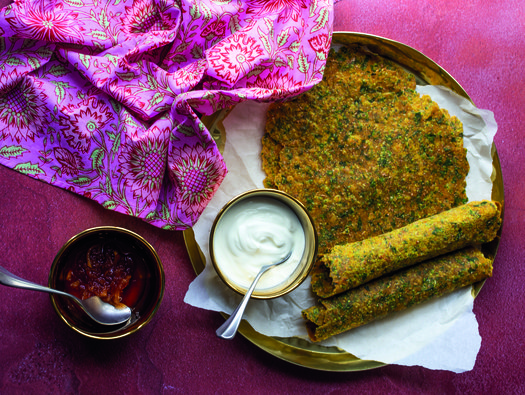Methi Thepla with yoghurt and mango chutney

Theplas are typically eaten at breakfast or as a part of main meal instead of a chapatti or taken in a lunch box.

Theplas are typically eaten at breakfast or as a part of main meal instead of a chapatti or taken in a lunch box.
30g fresh methi leaves (fenugreek leaves)
¼ teaspoon turmeric powder
¼ teaspoon chilli powder
¼ teaspoon cumin powder
½ teaspoon garam masala
¼ teaspoon ajwain/carom seeds
1 tablespoon sesame seeds, optional
1 teaspoon ginger paste
One pinch asafoetida (hing), optional
2 tablespoons plain yoghurt
70g wholemeal flour
30g gram flour (besan)
3 tablespoons oil (for dough and cooking)
120ml plain yoghurt
4 teaspoons sweet mango pickle (chundo)
Finely chop the methi leaves into a large bowl. Add the turmeric, chilli, cumin, garam masala powders, ajwain and sesame seeds, ginger paste and pinch of asafoetida (if using). Add 2 tablespoons of plain yoghurt and mix well, making sure all spices are well combined.
Now add the wheat flour and gram flour and mix into a dough. Knead, adding enough oil to make a non-sticky dough. Cover and rest for 15 minutes.
Divide the dough into 4 parts and form small, round balls. To make the thepla, roll one ball at a time as thin as possible. Heat a pan, apply a little oil and cook each thepla over a medium heat. Flip over to cook both sides, applying a little more oil to the pan for the second side. Repeat until all 4 are cooked.
Serve with plain yoghurt and mango chutney.
Wheat flour is the main source of carbohydrate in this recipe. The value has been provided if you have been trained in insulin adjustment.
Despite the use of some high-potassium ingredients, such as fenugreek, this recipe is low in potassium when following quantities and serving sizes given, so is suitable if you have been advised to reduce the amount of potassium in your diet. This recipe is also low in phosphate; however, it does contain some phosphate, mainly provided by the yoghurt, so if you have been prescribed a phosphate binder, take as directed.
This recipe provides a source of protein. If you have been advised to eat more protein, consider having a small portion of paneer/beans/lentils/meat curry instead of plain yoghurt to increase the protein content.
Fenugreek leaves are rich in calcium and magnesium and have the beneficial effect of reducing cholesterol.
Once cooked and cooled, theplas can be stored in an airtight container or wrapped in foil and stored in the fridge for up to a week. They can be reheated and are also suitable for freezing.
By giving us your email address, you're giving us permission to send you the latest news from Kidney Care UK. Further information about how we protect and use your personal data is available in our Privacy policy. If you would like to change the way we communicate with you at any time please email [email protected]. You can unsubscribe at any time by using the link at the bottom of every email we send.